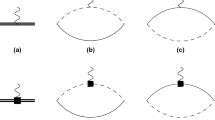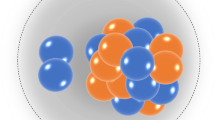Abstract.
Nuclei feature a rich variety of many-body phenomena. Especially the clustering of nucleons, which leads to molecule like structures, and halos formed by weakly bound nucleons are regarded as exotic phenomena that standard many-body methods like the shell model have difficulties to describe. On the other hand cluster models that build in such structures explicitly use very simplistic effective interactions and have often difficulties if shell model like configurations become important. In the Fermionic Molecular Dynamics approach we aim at a consistent description of well bound nuclei with shell structure as well as of nuclei featuring halos or clustering. We achieve this by exploiting the versatility of Gaussian wave packets. These are able to describe harmonic oscillator single-particle states and cluster states on the same footing. If we allow the width parameter to be a free variational parameter also halos can be described well in this basis. The many-body basis is given by Slater determinants of these wave packets. Different levels of sophistication can be achieved. In the simplest approach we perform a mean-field calculation by variation of the energy expectation value with respect to the single-particle parameters. The mean-field state might break the symmetries of the Hamiltonian which can be restored by explicit projection on parity, angular and linear momentum. In a more sophisticated approach we can perform the variation after projection. An approximate variation after projection can be done in the sense of the generator coordinate method where the intrinsic state is varied under constraints on generator coordinates like the radius or quadrupole deformation. Finally we can perform a multiconfiguration mixing calculation by diagonalizing the Hamiltonian in a set of projected many-body basis states. The same effective interaction is used for all nuclei. It is based on the VUCOM interaction derived from the realistic Argonne V18 interaction by explicitly including short-range central and tensor correlations within the Unitary Correlation Operator Method.
Similar content being viewed by others
References
S.C. Pieper, R.B. Wiringa, Ann. Rev. Nucl. Part. Sci. 51, 53 (2001)
P. Navrátil, G.P. Kamuntavičius, B.R. Barrett, Phys. Rev. C 61, 044001 (2000)
Y. Kanada-En'yo, H. Horiuchi, Prog. Theor. Phys. Suppl. 142, 205 (2001)
Y. Kanada-En'yo, M. Kimura, H. Horiuchi, C. R. Physique 4, 497 (2003)
T. Neff, H. Feldmeier, K. Langanke (2007) [arXiv:nucl-th/0703030v1]
A.B. Volkov, Nucl. Phys. 74, 33 (1965)
D.R. Thompson, M. Lemere, Y.C. Tang, Nucl. Phys. A 286, 53 (1977)
V.G.J. Stoks, R.A.M. Klomp, M.C.M. Rentmeester, J.J. de Swart, Phys. Rev. C 48, 792 (1993)
R. Machleidt, Phys. Rev. C 63, 024001 (2001)
V.G.J. Stoks, R.A.M. Klomp, C.P.F. Terheggen, J.J. de Swart, Phys. Rev. C 49, 2950 (1994)
R.B. Wiringa, V.G.J. Stoks, R. Schiavilla, Phys. Rev. C 51, 38 (1995)
S.C. Pieper, V.R. Pandharipande, R.B. Wiringa, J. Carlson, Phys. Rev. C 64, 014001 (2001)
D.R. Entem, R. Machleidt, Phys. Rev. C 68, 041001 (2003)
E. Epelbaum, Prog. Part. Nucl. Phys. 57, 654 (2006)
R. Jastrow, Phys. Rev. 98, 1479 (1955)
M. Hjorth-Jensen, T.T.S. Kuo, E. Osnes, Phys. Rep. 261, 125 (1995)
J.R. Gour, P. Piecuch, M. Hjorth-Jensen, M. Włoch, D.J. Dean, Phys. Rev. C 74, 024310 (2006)
S.K. Bogner, T.T.S. Kuo, A. Schwenk, Phys. Rep. 386, 1 (2003)
H. Feldmeier, T. Neff, R. Roth, J. Schnack, Nucl. Phys. A 632, 61 (1998)
T. Neff, H. Feldmeier, Nucl. Phys. A 713, 311 (2003)
R. Roth, H. Hergert, P. Papakonstantinou, T. Neff, H. Feldmeier, Phys. Rev. C 72, 034002 (2005)
R. Roth, P. Papakonstantinou, N. Paar, H. Hergert, T. Neff, H. Feldmeier, Phys. Rev. C 73, 044312 (2006)
R. Roth, T. Neff, H. Hergert, H. Feldmeier, Nucl. Phys. A 745, 3 (2004)
K. Wildermuth, Y.C. Tang, A Unified Theory of the Nucleus (Vieweg, 1975)
D.M. Brink, The Alpha-Particle Model of Light Nuclei, in Proceedings of the International School of Physics “Enrico Fermi” course XXXVI (1965), p. 247
H. Feldmeier, Nucl. Phys. A 515, 147 (1990)
H. Feldmeier, J. Schnack, Prog. Part. Nucl. Phys. 39, 393 (1997)
H. Feldmeier, J. Schnack, Rev. Mod. Phys. 72, 655 (2000)
D.C. Liu, J. Nocedal, Math. Progr. B 45, 503 (1989)
P. Spellucci, Math. Prog. 82, 413 (1998)
H. Horiuchi, in Cluster models and other topics, edited by H. Horiuchi, K. Ikeda (World Scientific Publishing, 1986)
P. Ring, P. Schuck, The Nuclear Many-Body Problem (Springer, 2000)
A. Ozawa, T. Suzuki, I. Tanihata, Nucl. Phys. A 693, 32 (2001)
L.B. Wang, P. Mueller, K. Bailey, G.W.F. Drake, J.P. Greene, D. Henderson, R.J. Holt, R.V.F. Janssens, C.L. Jiang, Z.T. Lu et al., Phys. Rev. Lett. 93, 142501 (2004)
P. Navrátil, J.P. Vary, B.R. Barrett, Phys. Rev. C 62, 053411 (2000)
P. Navrátil, W.E. Ormand, Phys. Rev. C 68, 034305 (2003)
M. Chernykh, H. Feldmeier, T. Neff, P. von Neumann-Cosel, A. Richter, Phys. Rev. Lett. 98, 032501 (2007)
Y. Fukushima, M. Kamimura, in Proceedings of the International Conference on Nuclear Structure, edited by T. Muramori (Phys. Soc. Jpn. Suppl., 1978), Vol. 44, p. 225
M. Kamimura, Nucl. Phys. A 351, 456 (1981)
Y. Funaki, A. Tohsaki, H. Horiuchi, P. Schuck, G. Röpke, Phys. Rev. C 67, 051306R (2003)
Y. Kanada-En'yo, Prog. Theor. Phys. 117, 655 (2007)
M. Itoh, H. Akimune, M. Fujiwara, U. Garg, H. Hashimoto, T. Kawabata, K. Kawase, S. Kishi, T. Murakami, K. Nakanishi et al., Nucl. Phys. A 738, 268 (2004)
H.O.U. Fynbo, C.A. Diget, U.C. Bergmann, M.J.G. Borge, J. Cederkäll, P. Dendooven, L.M. Fraile, S. Franchoo, V.N. Fedosseev, B.R. Fulton et al., Nature 433, 136 (2005)
C.A. Diget, F.C. Barker, M.J.G. Borge, J. Cederekäll, V.N. Fedosseev, L.M. Fraile, B.R. Fulton, H.O.U. Fynbo, H.B. Jeppesen, B. Jonson et al., Nucl. Phys. A 760, 3 (2005)
F. Ajzenberg-Selove, Nucl. Phys. 506, 1 (1990)
E. Caurier, F. Nowacki, Acta Phys. Polon. B 30, 705 (1999)
Author information
Authors and Affiliations
Corresponding author
Rights and permissions
About this article
Cite this article
Neff, T., Feldmeier, H. Clustering and other exotic phenomena in nuclei. Eur. Phys. J. Spec. Top. 156, 69–92 (2008). https://doi.org/10.1140/epjst/e2008-00609-y
Issue Date:
DOI: https://doi.org/10.1140/epjst/e2008-00609-y




